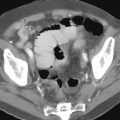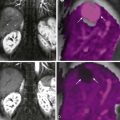Chapter Outline
Small Bowel Folds and Mucosal Changes
- Table 50-1.
- Table 50-2.
Small Bowel Lumen Dilated, Normal Fold Thickness
- Table 50-3.
Smooth, Straight, Thickened Folds
- Table 50-4.
- Table 50-5.
Irregular Fold Thickening, Diffuse
- Table 50-6.
Irregular Fold Thickening, Proximal Small Bowel
- Table 50-7.
Irregular Fold Thickening, Distal Ileum
- Table 50-8.
Tubular Bowel with Luminal Narrowing
- Table 50-9.
Tubular Bowel without Luminal Narrowing
- Table 50-10.
- Table 50-11.
Multiple Polyps and Polyposis Syndromes
- Table 50-12.
- Table 50-13.
Annular Lesion with Shelflike Margins
- Table 50-14.
Annular Lesion with Tapered Edges
- Table 50-15.
- Table 50-16.
Separation of Bowel Loops without Tethering
- Table 50-17.
Mass Effect with Tethering of Mucosal Folds
- Table 50-18.
The tables in this chapter ( Tables 50-1 to 50-18 ) concerning the differential diagnosis of small bowel diseases are not meant to be exhaustive. Instead, these tables present an approach for classifying the most common causes of various radiographic abnormalities in the small bowel in relation to the size, location, distribution, and radiographic characteristics of these abnormalities. A list of references is included for further reading.
| Parameter | Jejunum | Ileum |
|---|---|---|
| NORMAL PARAMETERS FOR ENTEROCLYSIS | ||
| Folds per inch length | 4-7 | 2-4 |
| Thickness of folds (mm) | 1-2 | 1.0-1.5 |
| Diameter of lumen (cm) | ≤4 | ≤3 |
| Wall thickness (mm) | 1.0-1.5 | 1.0-1.5 |
| NORMAL PARAMETERS FOR SMALL BOWEL FOLLOW-THROUGH | ||
| Thickness of folds (mm) | 2-3 | 1-2 |
| Diameter of lumen (cm) | ≤3 | ≤2 |
| Parameter | Cause | Comments |
|---|---|---|
| Diffuse small bowel dilation | Mechanical obstruction, small bowel or colon | Air-fluid levels on abdominal radiographs. CT if high grade obstruction suspected, barium studies for partial or intermittent obstruction Common causes—adhesions, hernias, metastases, radiation enteropathy, colonic carcinoma with backup into dilated small bowel |
| Adynamic ileus | Air-fluid levels to distal small bowel and in colon Common causes—postoperative, medications, ischemia, vagotomy Less common causes—systemic sclerosis (dilated duodenum, hidebound small bowel), amyloidosis, peritonitis, electrolyte imbalances (hypokalemia, uremia), blunt trauma, diabetes, hypothyroidism | |
| Focal small bowel dilation | Proximal obstruction | Fluid levels in few small bowel loops in upper abdomen—primary adenocarcinoma, postoperative strictures, adhesions |
| Focal adynamic ileus | Pancreatitis, postoperative manipulation or leak, pelvic irradiation | |
| Closed-loop obstruction Adhesions | Group of air-fluid levels unchanging in position CT for diagnosis and evaluation of possible strangulation | |
| Internal hernia | Focal region of dilated loops with air-fluid levels |
| Parameter | Cause | Comments |
|---|---|---|
| Diffusely distributed | Edema | Hypoalbuminemia—cirrhosis, nephrotic syndrome Protein-losing enteropathy Congestive heart failure Portal hypertension |
| Focal smooth fold thickening | Intramural hemorrhage Ischemia | Segmental stack of coins appearance; interspace spikes; thumbprinting on mesenteric border |
| Anticoagulants | Most patients return to normal within 2-3 wk | |
| Coagulopathies | ||
| Superior mesenteric vein thrombosis | ||
| Vasculitides | Ischemic changes, hemorrhage, ulceration or necrosis with small vessel disease (lupus, Henoch-Schönlein purpura) | |
| Blunt trauma | CT—look for possible perforation (e.g., mesenteric haziness or fluid, thickened bowel wall, lack of bowel contrast enhancement, focal pneumatosis, free intraperitoneal gas) | |
| Radiation enteropathy | Thickened folds, narrow interfold spaces (interspace spikes); barium changes resemble picket fence Changes confined to radiation portal |
| Cause | Comments |
|---|---|
| Whipple’s disease | White males with arthralgias, cardiovascular and neurologic symptoms CT—low-attenuation mesenteric lymph node mass |
| Mycobacterium avium-intracellulare (MAI) complex enteritis | AIDS MAI-laden macrophages in lamina propria CT—shows necrosis in enlarged lymph nodes |
| Abetalipoproteinemia | Adolescent with retinitis pigmentosa, acanthocytosis, spinocerebellar degeneration Retained fat globules in villous enterocytes |
| Histoplasmosis | Histoplasma -laden macrophages in lamina propria |
| Lymphangiectasia | Villi enlarged by dilated lacteals in primary form Edema in submucosa Mesenteric adenopathy causes secondary form |
| Macroglobulinemia | Lymphoma—may occur IgM macroglobulin in lamina propria |
| Radiation therapy | Associated with smooth, thickened, straight folds |
| Crohn’s disease | Distal, terminal ileum Aphthoid ulcers, mesenteric border ulcers; cobblestoning; strictures, fissures, fistulae |
* 1- to 2-mm mucosal nodules. Micronodularity implies villous enlargement caused by an infiltrative process in lamina propria. This table lists diseases that often involve the mucosa and submucosa and also produce abnormal folds.
| Cause | Comments |
|---|---|
| Lymphangiectasia, primary | Submucosal edema plus micronodularity Congenital hypoplasia of lymphatics |
| Lymphangiectasia, secondary | Small bowel changes (as above) Obstruction of lymph drainage by retroperitoneal fibrosis, radiation, mesenteric lymphadenopathy (Whipple’s, lymphoma) |
| Amyloidosis, types AA and AL | Fold thickening if deposits in vessels cause ischemia. Micronodularity in secondary amyloidosis—reflects amyloid deposits in lamina propria 4- to 10-mm nodules in submucosa (AL) |
| Mastocytosis | Histamine release–associated headaches, flushing, diarrhea; urticaria pigmentosa (50%), bone lesions (20%) Stomach, duodenum—ulcers Small bowel—multiple urticaria-like nodules Thickened folds often segmental |
| Immunoproliferative small intestinal disease (IPSID) | Relates to multiple parasitic and/or bacterial infections Patient from Mediterranean region Extensive lymphoid hyperplasia Responds to treatment |
| Mediterranean lymphoma | Young patient with progression of IPSID to monoclonal lymphomatous infiltrate Lymphoid nodules enlarged, nonuniform, confluent Lymph node masses Associated with a heavy-chain disease |
| AIDS | Large variety of infections cause diffuse thickened folds. |
| Graft-versus-host disease | Often with cytomegalovirus infection (see Table 50-8 ) |
| Cause | Comments |
|---|---|
| T-cell lymphoma complicating celiac disease | Diarrhea recurs despite gluten-free diet Nodular fold thickening in long segments May have annular lesions |
| Ulcerative jejunoileitis | Complicates celiac disease Before inflammatory infiltrate changes to monoclonal lymphoma Radiographically indistinguishable from T-cell lymphoma |
| Tropical sprue | History of sojourn in tropics Unlike celiac disease, folds are thickened, no separation of jejunal folds |
| Zollinger-Ellison syndrome | Gastric and duodenal ulcers Increased intraluminal fluid |
| Strongyloidiasis | Effaced folds, tubular bowel contour with severe disease |
| AIDS-related infections | Mycobacterium avium-intracellulare (MAI) complex, isosporiasis, cryptosporidiosis |
| Gastrojejunostomy | Thick folds in efferent loop just distal to gastrojejunal anastomosis |
| Jejunosotomy tube | Reaction to tube feeds |
Stay updated, free articles. Join our Telegram channel

Full access? Get Clinical Tree








